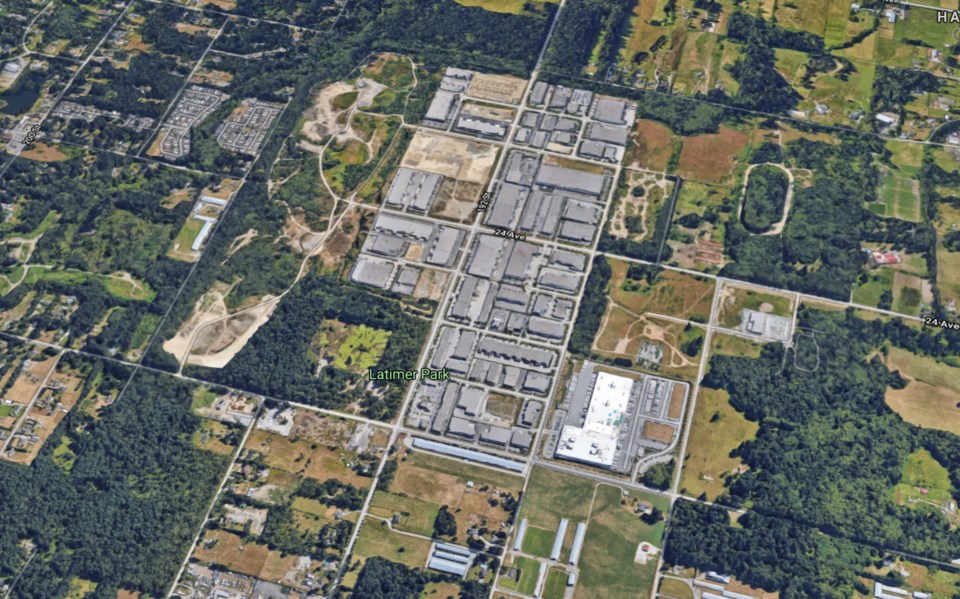Approval of a controversial industrial park proposal in Surrey has been delayed by Metro Vancouver directors seeking better consultation with the Semiahmoo First Nation.
On Friday, directors narrowly voted in favour of a motion by Surrey councillor Linda Annis for regional planning staff to consult further on the project with the Indigenous community, as well as the City of Surrey.
The conversion of 245 hectares of agricultural and watershed land, including an aquifer, to a light industrial-commercial park has raised questions over Indigenous reconciliation, environmental sustainability, economic growth and regional planning. Also at stake: where Metro Vancouver's mandate as a regional government begins and ends.
Located in a rural region in South Surrey and bordering Langley, the "South Campbell Heights" project requires approval from Metro Vancouver to alter the urban containment boundary, which is designed to contain urban sprawl.
Semiahmoo First Nation Chief Harley Chappell told the Metro board of directors his nation hasn’t been adequately consulted.
“The biggest part of my concern is consultation is not a box we tick and say ‘OK, we’ve consulted with the nation,’” said Chappell.
The Semiahmoo community resides at the mouth of the Little Campbell River, where it flows into Boundary Bay. The industrial park, according to local biologists, could put the health of salmon at risk.
Other concerns revolve around rising waters: by building industrial buildings further upstream, more hard surfaces mean rainwater may have a harder time penetrating the ground, and that could lead to a greater risk of flooding.
“In my eyes, my perspective, in speaking to council, we are not prepared to approve the moving forward of this project at this time,” said Chappell. “Unfortunately, we weren’t included in this application early on.”
Semiahmoo councillor Joanne Charles asked the board to delay the application.
After a back-and-forth discussion, Coun. Annis proposed the project be sent back to staff. The vote split 64-61, meaning a further delay to a project that Surrey last proposed in 2017.
At the time, Mayor Doug McCallum — who had yet to be elected — stated he opposed the project, citing environmental factors. By Friday, he had changed his mind, arguing for the project because of a redesign that's meant to ensure one-third of the space, largely set back from the river, is maintained as conservation space. McCallum also said the city has a right to make its own choices.
His council colleague, Mandeep Nagra, said Surrey needs the industrial space; without more, growth could push urban sprawl and traffic further east and into the Fraser Valley. Nagra said he was concerned Surrey would lose a chance for more jobs.
Jock Finlayson of the Business Council of B.C. spoke in favour of the project on economic grounds.
As did Chris Gardner of the Independent Contractors of B.C., who advocated for more jobs and better localization of the supply chain.
“We cannot expect to make our supply chain more robust if we continue to push supplies outside the region,” said Gardner.
Delta Coun. Dylan Krueger was among a handful of Metro directors who said they were concerned Metro Vancouver was creeping into local decision-making. “The buck doesn’t stop with us,” he said.
“We are not the supervisors of other communities,” echoed fellow Delta councillor Bruce McDonald.
But others, such as District of North Vancouver Coun. Lisa Muri, spoke in favour of Metro Vancouver’s authority to plan the region with a certain consistency.
Muri said growth must be viewed as finite in the face of climate change, and in approving Campbell Heights, “we are trying to have it both ways.”
“We can't keep expanding to accommodate our needs in the region,” said Muri.
Directors for the regional government also contemplated bylaws for the "Metro 2050" long-term regional plan. The plan includes significant climate change goals and preparations for the region to absorb a million more people by 2040.
Port Moody Mayor Rob Vagramov questioned why Metro had an urban containment boundary bylaw, if all that is needed to change it is an application by developers with municipal council support.
“Cities do not have the ultimate power to do whatever they want,” he said.
Directors heard from several local environmentalists claiming the industrial park will lead to more catastrophic flooding, which can risk salmon species that are genetically unique to Little Campbell River.
Bill Ridge, a local hatchery operator who sits on the board of the Semiahmoo Fish and Game Club, said over 100,000 fish are raised annually in the watershed. Those concerned about salmon, such as Ridge, have previously pointed to a contradiction in backing development plans such as the South Campbell Heights project, and the $647 million the federal government pledged last year to restore salmon habitat on the Pacific coast.
Langley resident Peter Stepney noted more frequent and stronger storms, such as the atmospheric river event that hit B.C. last November, are all the more reason to maintain the area as green space.
Urban planner Alex Boston, executive director of Renewable Cities program at Simon Fraser University, echoed Stepney's concerns.
“We are looking at increased risk of significant catastrophic losses for the community of Semiahmoo First Nation,” said Boston.
Boston, who poked holes in a project that doesn’t yet contemplate a transit plan for people to get to work in a far-off area of the region, said job spaces should be built along transit corridors. Campbell Heights is nowhere near the SkyTrain, he said.
Richmond councillor Harold Steves said the project imperils decades of regional planning. He wrote on Twitter, “I can't believe that after 54 yrs we're still fighting to save the Little Campbell River watershed.”
It is unclear when the proposal will return to the Metro board for a new vote.



